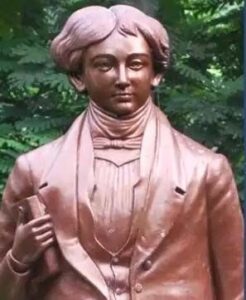Henry Louis Vivian Derozio was born on April 18, 1809, in Kolkata. He had a mix of Portuguese, Indian, and English backgrounds. He played a crucial role in starting Anglo-Indian poetry. Derozio was known in his time as the first ‘national’ poet of modern India. Even after he passed away, his ideas and teachings stayed with his former students, who were called the Young Bengals.
His father, Francis Derozio, was a Christian of Indo-Portuguese background, and his mother, Sophia Johnson Derozio, was English. Their original family name was “do Rozário.”
Derozio went to the David Drummond Dharmatala Academy school from the age of 6 to 14. Derozio’s religious thinking was influenced by David Drummond, who was a freethinker. Newspapers like the India Gazette and the Calcutta Journal praised Derozio’s academic excellence and performance during his time at school. While he was a student, he read the poetry of famous writers like John Keats, Percy Shelley, and Lord Byron.
When Derozio was 14, he left school and started working. First, he worked in his father’s office in Kolkata, and later, he moved to his uncle’s indigo factory in Bhagalpur. Inspired by the beautiful surroundings along the banks of the River Ganges, he began writing poetry. He sent some of his poems to the India Gazette, and in 1825, his poetry started getting published in various newspapers and magazines.
In 1827, when Derozio was 18, a man named John Grant, who was an editor, noticed his poetry. He offered to publish a book of Derozio’s poems and invited him to come back to Kolkata. Derozio became an assistant editor for Grant and also wrote for other magazines. He even started his own newspaper, the Calcutta Gazette.
In May 1826, when he was just 17 years old, Derozio became a teacher at the new Hindu College. He was very passionate about teaching and became very popular among the students. In 1828, he encouraged the students to create a club called the Academic Association, where they could discuss and debate various topics, including Western knowledge and science.
In 1828, Raja Ram Mohan Roy started the Brahmo Samaj, which followed Hindu principles but didn’t believe in idol worship. This caused some controversy in the traditional Hindu community. Derozio was part of conversations about these changes. Despite being young, he was seen as a great scholar and thinker. He gathered a group of bright students around him and encouraged them to think freely, ask questions, and not accept things blindly. His teachings inspired ideas of freedom, equality, and liberty. They also aimed to address social problems, improve the status of women and farmers, and promote freedom of the press and jury trials. Derozio’s activities led to an intellectual revolution in Bengal, known as the Young Bengal Movement, and his students, called Derozians, were passionate patriots.
Because some conservative parents didn’t like the way Derozio openly discussed religious matters, he lost his job in April 1831, shortly before he passed away. He died of cholera at the age of 22 on December 26, 1831, in Calcutta. He was buried in South Park Street Cemetery.
After his death, in 1838, members of the Young Bengal movement created another group called the Society for the Acquisition of General Knowledge. Their main goal was to learn and share knowledge about the state of the country.
Derozio’s thoughts had a big impact on a social movement called the Bengal Renaissance. The Bengal Renaissance was a cultural, social, intellectual, and artistic movement that took place in the Bengal region of the British Raj, from the late 18th century to the early 20th century.
Some people, like Alexander Duff and many Christian Missionaries, didn’t completely agree with Derozio’s ideas. They saw him as a rebel. However, in Duff’s Assembly’s Institution, they did like some of Derozio’s ideas about thinking logically and reasonably, as long as they didn’t clash with the core beliefs of Christianity and as long as they criticized traditional Hinduism.
A commemorative postage stamp of Derozio was issued on December 15, 2009.
Literary Works:
Poems (1827) – The Harp of India, Song of the Hindoostani Minstrel.
The Fakeer of Jungheera: A Metrical Tale and Other Poems (1828) – The Fakeer of Jungheera, To India – My Native Land.
The Poetical Works of Henry Louis Vivian Derozio, ed. B.B. Shah (1907) – To the Pupils of the Hindu College.
